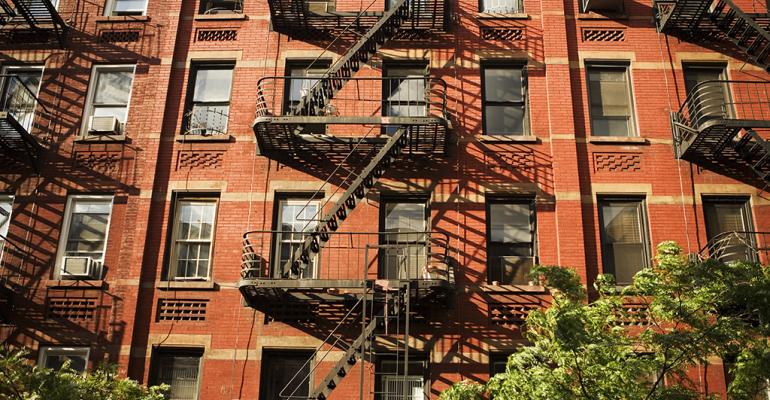With the ever-changing landscape of debt and equity sources, market competition for multifamily assets remains strong, placing pressure on borrowers to include sufficient capital reserves in their underwriting models and solidify their offerings. Building stock that was constructed more than 20 years ago must account for a variety of additional maintenance and repair issues as the expected useful life (EUL) of these components nears expiration. The following issues faced by aging housing stock can significantly affect the mechanics of arranging acquisition loans and refinancing for these assets.
In addition to the typical seven to 20-year multifamily capital reserve items such as flooring, appliances, water heaters, condensers/FAUs, exterior paint, roofing and pavement, aging housing stock may need to plan for repair or replacement of longer-lasting components such as siding, brick/mortar, wood exterior structural components, galvanized piping, clay tile roofs, fused subpanels, FPE panels and windows.
Wood siding and framing
Wood siding has an EUL of about 40 to 50 years. Fascia, soffit and trim boards exposed to weather have an EUL of 40 years or less. Wood siding installed prior to 1985 may be nearing its EUL, which can be extended through superior maintenance practices such as caulking replacement every 10 to 12 years and painting every seven to eight years.
Wood framing members exposed to the elements can last from 20 to 40 years, depending on environmental conditions and maintenance practices. Typical wood frame exterior members consist of balconies, exposed rafter tails, upper level walkways and exposed stairways or breezeway components. Prolonged exposure to moisture and sunlight can accelerate degradation of these components. Wood exterior structural members installed prior to 1985 may be nearing their EUL, which can be extended through superior weather protection with frequent painting/sealing, caulking, flashings and correcting the slope of walking surfaces. A lack of proactive maintenance can cause early failure of wood exterior components, with potentially costly remediation efforts.
Aging brick and mortar issues
Aging brick and mortar has EUL of 30 to 40 years, and should be periodically “tuck-pointed” to improve water penetration resistance and appearance. Deferment of this maintenance can lead to water penetration inside the structure that can cause water damage, damage to interior elements, microbial growth and loss of energy, or introduce new risks related to façade ordinance compliance.
Bricks, which can have an EUL of 100 years, tend to break down if not property supported and encapsulated by adequate mortar applications. Costs for brick/mortar repairs can be significant if not maintained properly. Brick mortar installed prior to 1985 may be nearing its EUL. The EUL can be extended through superior maintenance practices such as tuck pointing and caulking replacement every 10 to 12 years, and inspection and pointing on a frequent basis as needed.
Piping and roofing
Galvanized piping tends to corrode from the inside out. This reduces water pressure first as the annular space builds up with corrosion and eventually develops leaks. These pipes typically exhibit signs of failure at or around the 40-year mark, and failure can be accelerated by the chemical composition of the water supply. There are no known practices for extending the EUL of this component.
Clay roofing tiles are an attractive product due to their EUL being nearly double that of asphalt shingles. They generally last somewhere between 40and 50 years. As they age, they begin to breakdown via cracking, settling and spalling.
Electric service issues
Fused subpanels were an overcurrent protection precursor to circuit breakers and were used widely in residential construction pre-1960. Generally speaking, these systems are often under capacity by today’s standards and may be unsafe and obsolete. One of the successors to fused panels, Federal Pacific Stablock Panels, were installed in all regions of the U.S. during the late 1960s through mid-1980s and are commonly found in older multifamily assets. These panels are suspect due to improper calibrations by the parent manufacturing company when they were tested for use by Underwriters Laboratories and are known in some cases to not trip during overload situations—thereby posing safety issues.
Window systems
Older window systems were typically made of single-pane aluminum or wood. Window gaskets tend to break down, causing a loss of energy and allowing moisture to get in. Additionally, these older windows and sliding glass doors, with an EUL of 40 to 50 years, can become difficult to open over time due to wear and tear.
Environmental issues
Asbestos-containing materials were commonly used in older multifamily assets. They are still used in certain products and must be evaluated for condition and potential for disturbance. Use of lead-based paints was also common in older assets and was banned in residential applications in 1978. Use of lead-based paints should be identified and similarly evaluated for condition, potential for disturbance, the presence of children under the age of six residing at the property and conformance with EPA/OSHA regulations.
Underground storage tanks can also be an issue for older multifamily assets as they have a useful life of only 15 to 20 years, resulting in multiple generations of tanks that often lack proper closure reports when replaced or during conversion to an alternative fuel source.
As multifamily properties continue to be an investment asset of choice in many parts of the country, lenders, investors and sellers should be mindful of these issues and put in place sufficient capital reserves to address these inevitable long-term maintenance issues.
Robert J.M. Occhiogrossi serves as managing director of CBRE Assessment & Consulting Services. For more than 20 years, he has conducted and overseen due diligence for an array of asset types and clients, including institutional and private equity investors, REITs, lenders and owners.

